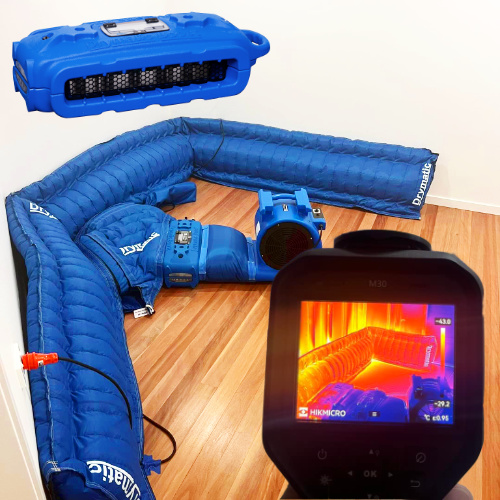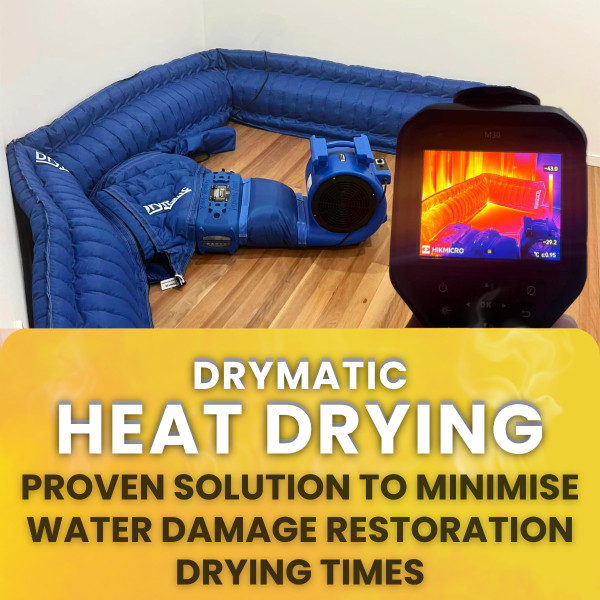Heat Drying: The Game-Changer in Water Damage Restoration
When water damage strikes, whether from a burst pipe, flooding, or an unforeseen leak, the clock starts ticking. The longer water sits in a structure, the greater the risk of secondary damage such as mould growth, structural weakening, and irreversible damage to furnishings. The ultimate goal in restoration is to return the affected area to its pre-loss condition as quickly and efficiently as possible. This is where heat drying steps in, offering a powerful solution that balances speed, effectiveness, and safety.
The Evolution of Heat Drying: From Fans to Advanced Technology
Heat drying, in one form or another, has been a part of the restoration industry for decades. Even the use of fans and dehumidifiers—a staple in water damage recovery—essentially involves adding heat to a space. These pieces of equipment increase the energy within a room, contributing to the drying process by promoting air movement and lowering humidity levels.
As restoration practices evolved, so did the understanding of how to optimise the drying process. The use of specialised heat drying equipment represents a natural progression in the field, allowing restoration technicians to take control of temperature and truly harness the science of heat. By doing so, they can enhance the drying process, making it faster, more efficient, and more effective at achieving the desired outcome.
The Science Behind Heat Drying: Optimal Drying in Any Climate
Heat drying is a technique that has revolutionised the restoration industry. By raising the temperature of water-damaged materials, heat drying increases their vapour pressure, which accelerates the evaporation process. This is particularly effective in environments where moisture can be deeply embedded in materials like hardwood floors, drywall, or insulation.
The science is straightforward: warm air holds more moisture than cool air. By heating the affected area, you’re not only increasing the temperature of the materials but also the surrounding air, which can then absorb more moisture. This moisture-laden air is then removed from the environment using dehumidifiers, creating a continuous cycle of drying that significantly reduces the time needed to restore a space.
The DBK Drymatic Heat Drying System: Innovation in Action
Among the various heat drying systems available, the award-winning DBK Drymatic Heat Drying System stands out for its adaptability and efficiency. Designed to reduce drying times and cater to a broad range of structural drying needs, the DBK Drymatic system is a game-changer in the restoration industry.
Key features of the DBK Drymatic system include:
- Intelligent Heat & Air Exchange: This system optimises drying conditions by intelligently managing temperature and airflow, ensuring that the environment remains conducive to efficient drying.
- Reduced Drying Time: By accelerating the evaporation process, the DBK Drymatic system significantly shortens the time needed to dry out affected areas, which is crucial for preventing mould growth and minimising disruption to occupants.
- Versatility: The system excels in Class 4 drying conditions, which involve situations where water is deeply absorbed in low-permeance materials like concrete, hardwood, and plaster. It also comes with a range of attachments, including target drying mats, which allow for precise drying of specific areas.
- Safety and Portability: Despite its powerful output, the DBK Drymatic system is designed with safety in mind, featuring touch-safe heater outlets and portable components that allow for quick setup and operation without compromising on safety.
Heat Drying Equipment Essentials: Accompanying Tools of the Trade
Heat drying is not a one-size-fits-all solution. It requires a combination of specialised equipment, each playing a crucial role in the drying process:
- Targeted Heaters: These heaters deliver hot air directly into the affected area, making them highly effective in large spaces.
- Heat Exchange: Utilising heat exchange, heating the air allows for accompanying equipment such as dehumidifiers to pull the wet air from the air.
- Heat Mats: These are essential for targeted drying. Placed directly on wet surfaces, heat mats provide focused heat to specific areas, making them ideal for drying out hardwood floors or other materials by pushing energy into the surface and releasing moisture from the affected materials.
- Dehumidifiers: An indispensable part of the heat drying process, dehumidifiers work alongside heaters to remove moisture from the air, preventing reabsorption by the materials and ensuring that the drying process continues efficiently.
- Air Movers: By circulating the heated air, air movers ensure that the warm, dry air is consistently in contact with the wet materials, enhancing the overall drying process.
Advantages of Heat Drying: Why It’s the Preferred Choice
 The benefits of heat drying are numerous, making it a preferred method in the restoration industry:
The benefits of heat drying are numerous, making it a preferred method in the restoration industry:
- Speed: Perhaps the most significant advantage of heat drying is the reduction in drying time. Traditional drying methods can take days or even weeks, whereas heat drying can complete the process in a fraction of the time.
- Efficiency: Heat drying is particularly effective in situations where moisture is deeply embedded in materials. By raising the temperature, the moisture is drawn out more effectively, ensuring a thorough drying process.
- Adaptability: Whether you’re dealing with residential, commercial, or industrial properties, heat drying can be adapted to various environments and materials, making it a flexible tool in the restoration professional’s arsenal.
- Energy Efficiency: While initial energy usage may be higher, the DBK Drymatic system quickly reaches the target temperature and then optimises energy consumption, resulting in lower overall usage compared to traditional methods that may need to run for extended periods.
- Advanced Injection Drying Capabilities: The DBK Drymatic Boost Bar System offers 22-port, 12-port, 5-port, 4-port, and 3-port and L Shape kits specifically designed for injection heat drying. This method is particularly beneficial for drying hard to reach areas, such as wall cavities, subfloors, or insulation layers. Injection heat drying works by introducing warm air directly into these confined spaces, which helps to dry them more efficiently without the need for invasive measures like tearing down walls or lifting floors. This targeted approach not only speeds up the drying process but also minimises disruption and reduces the overall cost of restoration.
Challenges and Considerations: The Other Side of the Coin
 While heat drying offers numerous benefits, it’s not without its challenges:
While heat drying offers numerous benefits, it’s not without its challenges:
- Potential for Damage: Excessive heat, if not carefully managed, can damage certain materials. Delicate fabrics, electronics, and even some structural components may be adversely affected by prolonged exposure to high temperatures, but the DBK Drymatic system allows for precise control over temperature and humidity. With the ability to set limits on both the Drymatic D2 and Boost Bar, the risk of damage is minimised, ensuring that the drying process is safe for all materials involved.
- Safety Concerns: Operating heaters in enclosed spaces requires careful consideration of ventilation and temperature control to avoid creating hazardous conditions. While there are many options in the market, including those from large department stores, not all heat drying equipment is rated to be left unattended. The DBK system, however, has undergone rigorous safety testing and is approved by the Electrical Equipment Safety System (EESS), making it safe to be left unattended. For more information, you can visit the EESS website.
- Skill and Expertise: Successful heat drying typically requires a deep understanding of the method and the materials being dried. However, the DBK Drymatic system is designed to be user-friendly, with large colour screens, clear settings, and labelled outlets on the D2, making it easy for even less experienced technicians to learn and use. Additionally, fittings and adaptors are designed to avoid incorrect usage, further simplifying the process and reducing the margin for error.
In the world of water damage restoration, time is of the essence. The faster a space can be dried, the less likely it is that secondary damage will occur. Heat drying, with its ability to accelerate the evaporation process and reduce drying times, has become a cornerstone of modern restoration techniques. Systems like the DBK Drymatic offer innovative solutions that make heat drying more adaptable, efficient, and safe than ever before.
While there are challenges to consider, the advantages of heat drying far outweigh the potential drawbacks, making it an indispensable tool for restoration professionals. Whether dealing with a minor leak or a major flood, heat drying ensures that affected areas are returned to their pre-loss condition quickly and effectively, allowing homeowners and businesses to resume normal operations with minimal disruption.
Recent Posts
-
Start the Year Strong with Our Restocking Service
Because the busiest season is when you need the fewest surprises. The new year is already in full sw …3rd Jan 2026 -
Ten Years of Restore Solutions: Innovation for Restorers
In 2015, Restore Solutions entered the market with one clear purpose — to help restoration professio …2nd Dec 2025 -
The Ultimate Battery Operated Power Scrubber for Restoration Professionals
Less Elbow Grease, More Results: Meet the Battery-Powered Scrubber That Does the Hard Work for You S …17th Nov 2025




